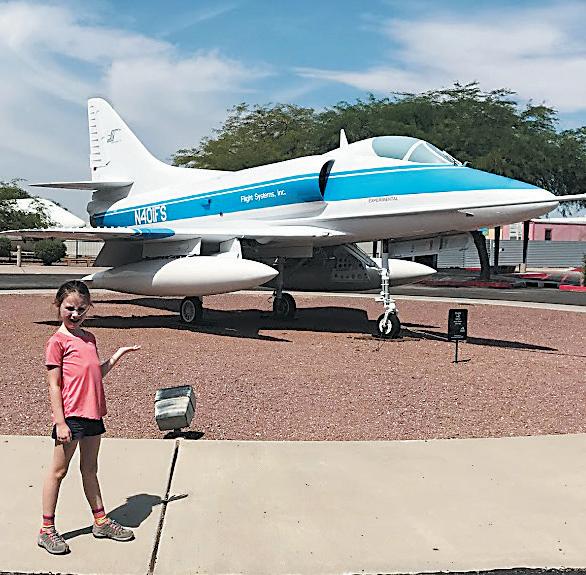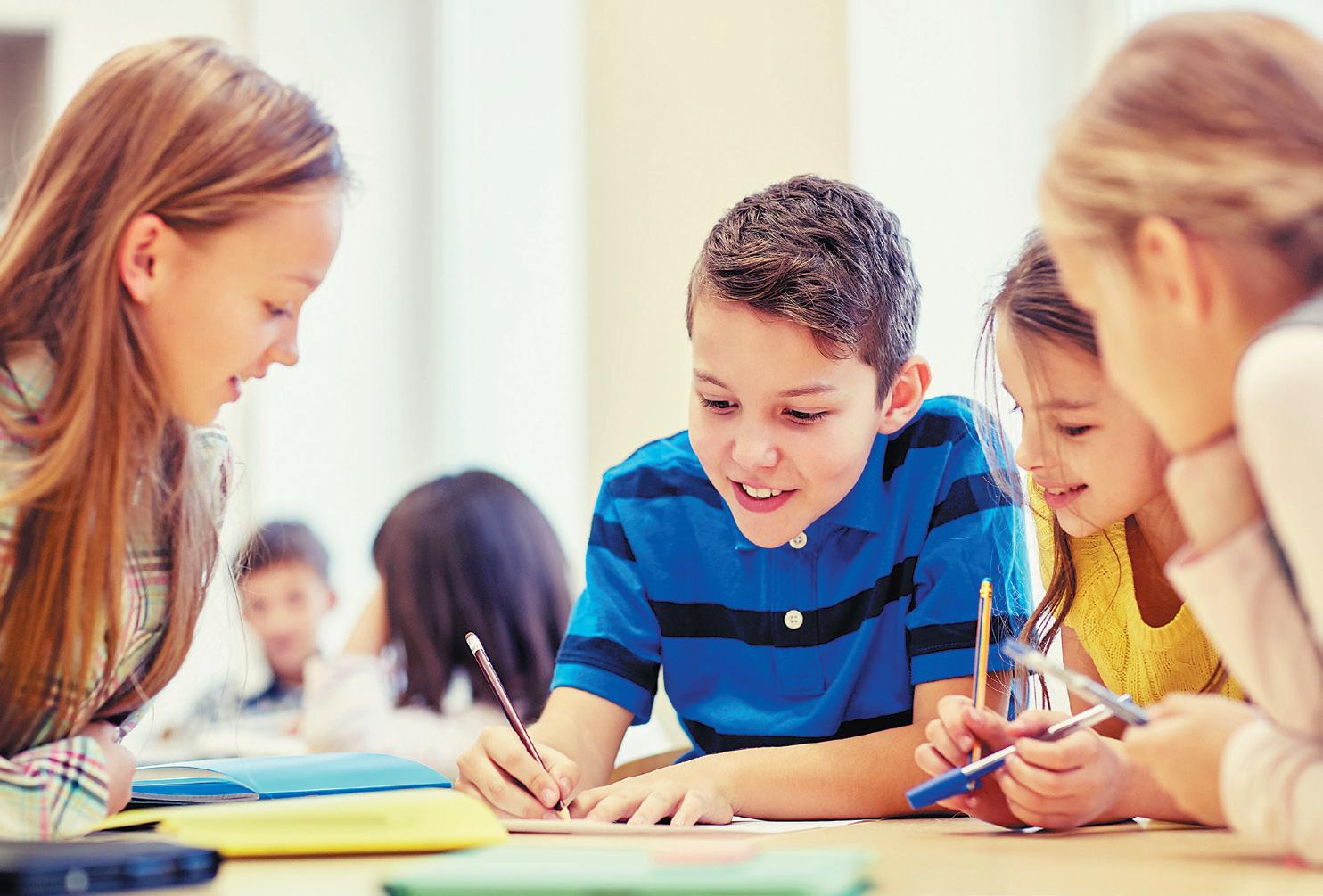
13 minute read
Getaway
Visiting SOUTHERN ARIZONA
By Jill “MamaBug” Frier

It’s always surprising to hear how many Phoenicians have never spent time in Tucson. Just a short distance south of the Phoenix metropolitan area is a charming gem of southwestern sights to see. Tucson is home to the University of Arizona, but ASU fans shouldn’t let that stop them from enjoying the many fascinating places to see in Pima County. The hotels and resorts are plentiful, but our advice is do your research and look at the map to plan your trip. Tucson is much more than what you can see while driving down the highway, and the limited view from I-10 just doesn’t do it justice. Here are our favorite spots to visit while in Tucson.
ARIZONA SONORAN DESERT MUSEUM
It’s a zoo. It’s a botanical garden. It’s a museum. It’s all of the above! The Arizona Sonoran Desert Museum is located in mountainous desert on the west side of Tucson, but still right down the road from both Old Tucson Studios and Saguaro National Park West. The museum provides visitors with gorgeous views of Sonoran Desert fl ora and fauna in a botanical garden type of setting. A stroll down the paved and unpaved trails takes you near enclosures that are home to various creatures native to the Sonoran Desert, from hummingbirds and butterfl ies, to javelinas, hawks, bears and mountain lions.


One of our favorite exhibits is the geological display, located in a mineshaft trail that takes you underground to see the wonders of Arizona’s Sonoran Desert under the surface. This state-of-the-art facility is a must-see if you are in Tucson – and worth planning a trip just to go there on the weekend.



OLD TUCSON STUDIOS
Ever wonder where they made your favorite Western? It was probably right here in Old Tucson Studios. Located on the west side of Tucson, just down the road from the Arizona Sonoran Desert Museum, more than 400 movies have been produced at Old Tucson over the years - and they’re still going strong. With live entertainment, rides, tours and plenty to see, this is a great place to visit when you head to Tucson.


SAGUARO NATIONAL PARK – EAST AND WEST
Some of the most beautiful hiking spots in Arizona are found in Saguaro National Park West and East. The West part of the National Park is home to a fantastic display of petroglyphs, mountains and Saguaros. The East part of the park provides an entirely different view of the pristine Sonoran Desert, mountain ecosystems and desert wildlife. Everything the Sonoran Desert has to offer is available in two completely different parks, focused on the same purpose – preserving the mighty Sonoran Desert and the Saguaros that give the National Park its name.
KARTCHNER CAVERNS STATE PARK
Do you love fantastic caves and beautiful desert vistas? Then you’ll love visiting Kartchner Caverns State Park. It’s opening in 1999 makes it a somewhat recent addition to the Arizona State Park system. Located southeast of Tucson, near Saguaro National Park East, Kartchner Caverns State Park provides facilities for camping, hiking and of course touring the caverns. Be sure to book your cave tour tickets in advance because tours book up very quickly!
PIMA AIR AND SPACE MUSEUM
If you love aircrafts, space and the history of fl ight, then the Pima Air and Space Museum should be on your must-see bucket list. This museum is one of the largest non-government funded aviation and space museums in the world, featuring over 350 historical aircrafts from a Wright Flyer to a 787 Dreamliner. The museum, which opened in 1976, is located on 80 acres in the southeast part of Tucson, near Davis–Monthan Air Force Base.
The Pima Air and Space Museum houses six indoor exhibit hangars, three of which are dedicated specifi cally to World War II. Walking tours and museum ground Tram Tours are offered daily. The museum is also the exclusive operator for bus tours of the “Aircraft Boneyard,” a 2,600-acre U.S. military and government aircraft storage facility also located in Tucson. If you love aircrafts, be sure to plan a visit to the Pima Air and Space Museum. But give yourself plenty of time to explore – the museum is huge and there are hours worth of airplanes and historical displays to see!
SABINO CANYON RECREATION AREA
If you are looking for a beautiful place to get outdoors for some hiking, biking or trail running, Sabino Canyon is home to a range of trekking opportunities from paved paths and easy trails, to more rugged mountainous terrain. Located at the base of the Santa Catalina Mountains on the northeast edge of Tucson, Sabino Canyon offers visitors a chance to see one of the premier natural areas in southern Arizona. Sabino Creek fl ows almost year around and the Sabino Canyon tram offers narrated, educational 45-minute tours every day. The tram route begins and ends at the Visitor’s Center, with stops at points along the road to drop off and pick up hikers at the various trailheads. This is a wonderful spot to get a fl avor for the beautiful Tucson wilderness.
BIOSPHERE 2
The Biosphere 2 is one of the most interesting and educational attractions we have visited in Arizona. One of the world’s most unique facilities, the Biosphere 2 is dedicated to the research and understanding of global scientifi c issues. The facility is a working laboratory for controlled scientifi c studies, an arena for scientifi c discovery and discussion, and is a far-reaching provider of public education. The mission of Biosphere 2 is “to advance our understanding of the natural and man-made environment through unique experimentation, training of interdisciplinary scientists, science education and public outreach, and organization of meetings to address grand challenges that affect the quality of life and the understanding of our place in the universe.” This facility defi nitely does that – and it’s open to the public for tours.
Biosphere 2 is located north of Tucson, near Oracle, and you can reach it on the way into Tucson if you are traveling down AZ Highway 77 from Florence, AZ. There is really nothing like Biosphere 2. Make a point to stop and take a look the next time you head to Tucson – it’s worth the trip!
These are just a few of our favorite places to visit in Tucson, but there are many more spots worth seeing so take some time to stop and enjoy the desert scenery. And be sure to check out Ladybug’s Blog (www.LadybugsBlog.com) for more fun things to do with kids everywhere in Arizona!
PRESCOTT, AZ www.friendlypines.com (928) 445-2128 info@friendlypines.com
JOIN US this summer!
OPEN HOUSE March 30 11AM-2PM
Boys and girls, ages 6-13 One & Two-Week Sessions Over 30 activities to choose from!
“An Arizona Tradition...
turning childhood moments into life’s rich memories.”
NOW OPEN!
JAGGED EDGE
HAIR SALON
WE OFFER: OYA/Goldwell Products
Women, Men & Children’s Hair Cuts
Corrective Coloring • Brazillian Blowouts
Balayage & Ombre • Eyebrow Waxing
Roller Sets & Updos • Hair Extensions 29834 N. Cave Creek Rd. #106 • Cave Creek, AZ (Located in Safeway shopping center next to Subway) 480.563.3157 www.jaggededgesalons.com Hairstylist wanted!!! Tues-Fri: 10am-6pm Saturday: 9am-4pm Sunday: Closed
Monday: By Appointment Only 20% Off Any Hair Service
Must Present Coupon. Exp. 2/28/19.

COVER STORY CURIOSITY OPENS MINDS 5 WAYS FOR YOUR CHILD TO EXPLORE, LEARN, AND GROW
By Cory Dobbs, Ed.D., Paradise Valley Unifi ed School District
WORLD-CLASS THINKING
The world is changing rapidly and more intensely than perhaps at any other time in recent history.
The challenges of preparing the 21st century student to function in tomorrow’s workforce are plentiful. According to research from the World Economic Forum, 35 percent of the skills necessary to succeed in today’s workplace will be dramatically different fi ve to 10 years from now. In a world saturated with information, it’s imperative that today’s schools meet the long-term needs of the learner.
Today we know with full clarity that the workplace of tomorrow demands fl uency in problem-solving and the ability to work interdependently. In other words, the basic skills needed for tomorrow’s knowledge-based workforce are wrapped up in techniques of thinking and communication. To be effective educators and parents, we must foster thinking in the child’s life. If we want to unlock the potential of a child,

it’s essential that we fi nd ways to help them explore, learn, and grow.
The world of the future insists students know how to develop and practice advanced thinking skills. The mission of PVSchools is to “cultivate, lead, and inspire world-class thinkers and expert communicators.” The accelerating world that’s coming into focus stresses nurturing and promoting multiple kinds of thinking. The following fi ve types of thinking will enable today’s student to meet tomorrow’s challenges.
INTEGRATED THINKING
STEM (science, technology, engineering, and math) education has emerged as a new system of knowledge for the next generation of students. STEM education provides learners the opportunity to acquire tangible problemsolving skills by bringing together knowledge from the different core areas necessary for participating in a technology-based world. Interdisciplinary STEM programs provide valuable opportunities for students to explore, learn, and grow.
Science Foundation Arizona defi nes STEM as “an integrated, interdisciplin-


ary approach to learning that provides hands-on and relevant learning experiences for students. STEM teaching and learning goes beyond the mere transfer of knowledge. It engages students and equips them with critical thinking, problem-solving, creative and collaborative skills, and ultimately establishes connections between the school, workplace, community and the global economy. PVSchools is committed to the exploration of science, technology, engineering and math in all content areas.
CREATIVE THINKING
Creativity is often thought of as something you either have or don’t have. We’ve all been told this is because some people are controlled by their logic-based left brain, while others march to the beat of the emotion sensing right hemisphere. The two hemispheres of the brain do function differently, but today we know we aren’t held captive by the way our brain works.
The real story of creativity is that on the one hand, some people are born with creative gifts. On the other hand, we now know creativity can be taught and learned.
PVSchools offers a variety of courses and programs that initiate and develop creative thinking. One such program, Suzuki Strings, shows how students can succeed by learning through creativity. The Suzuki Strings program embraces the educational philosophy of Shin’ichi Suzuki, a Japanese born educator. Suzuki believed that musical talent is not inborn, but rather all children could learn and master music. For Suzuki, the outcomes are clear: “Teaching music is not my main purpose. I want to make good citizens, noble human beings. If a child hears fi ne music from the day of his birth, and learns to play it himself, he develops sensitivity, discipline, and endurance. He gets a beautiful heart.”
CRITICAL /ANALYTICAL THINKING
The world is changing. As the second decade of the 21st century approaches, we’ve discovered an educational certainty: thinking matters. No longer is it just enough to know the answers. Students must create meaningful questions; the kind that requires skillful thinking. They must be prepared to integrate critical and analytical thinking in everything they do. Analytical thinking is like good detective work—goal oriented and reasoned. While critical thinking is the careful use of facts to form a judgment.
As a parent, you want to raise a wellrounded child who is academically challenged and thinks about issues and problems beyond the community in which he or she lives - a member of a global society. At PVSchools, we are helping students on this pathway with the K-12 International Baccalaureate (IB).
IB focuses on each student as a whole person and addresses, not only the cognitive development but social, emotional, and physical well-being. The IB teaching methods are research-based and draw from the best educational practices from around the world. Additionally, IB teachers are required to participate in professional development opportunities to promote awareness of current educational practices and new thinking.
INTERPERSONAL INTELLIGENCE
The nature of work is radically changing. Much of how work gets done today is through teamwork. Team building, as any coach will acknowledge, is not a cookie-cutter process. Nor is it just a matter of a coach’s leadership style. What Google and great sports teams validate is the power of unifi ed teams.
Google, one of the most infl uential
companies in the world, recently Their conclusion: it’s not simply who is concluded an extensive research on the team, rather it’s how the team’s project aimed at identifying how to members interact with one another that build high-performing teams. You see, determines its performance. To succeed Google, like all other 21st century in tomorrow’s workforce, students are thinking organizations understands going to need people skills. In today’s
“As the second decade of the 21st century approaches, we’ve discovered an educational certainty: thinking matters. No longer is it just enough to know the answers. Students must that future performance will be the domain of teams; the better the teams within an organization, the better the organization. So Google created an intechnology infused world, the cultivation of interpersonal skills is vital. At PVSchools, extracurricular activities such as athletics, band, clubs, and create meaningful questions; the kind that requires skillful thinking. ” tense project—Project Aristotle—and student-government, as well as the classinvested heavily in gathering data to room, help the young student develop figure out the best way to build better the abilities to collaborate, communicate, teams. and build effective relationships.
PRACTICAL THINKING
“Houston we have a problem.” These are the ominous words astronaut Jim Lovell uttered to the NASA command center on April 14, 1970. Lovell and his crew knew something was wrong with their spacecraft, but were unaware of the extent of the problem. Faced with a puzzle of a problem, Apollo 13’s revised mission became one of survival.
To bring the Apollo 13 spacecraft home safely, the crew and the command staff—more than 199,000 miles apart—had to apply practical thinking. Practical thinking is often referred to as “street smarts.” When you solve problems with the resources at hand, you are engaging in practical thinking. The astronauts aboard the spacecraft had to adapt to the situation, and deploy flexible thinking in the way they addressed problems as they emerged. They didn’t need to analyze data to draw conclusions. Getting the spacecraft back to Earth required using the practical intelligence of the astronauts. At PVSchools, the Career and Technical Education (CTE) Department offers a wide range of programs which provide students the rigor and relevance needed to succeed in today’s global economy. Students are presented with opportunities to develop specialized skills while in high school and apply their academic knowledge in real world settings.
Regardless of post-secondary plans, CTE provides all students with cutting edge training and opportunities in their chosen program of study.
HOW TO DEVELOP YOUR CHILD’S UNIQUE SET OF THINKING ABILITIES
Think about these questions:
• What is your child’s unique set of thinking abilities?
• Which environment brings them out?
• How and where can you intentionally leverage them?
A place for young minds
The Smart Choice.
PVSchools provides a robust and engaging educational experience, in a technology-rich environment, to ensure students are not only college and career ready, but prepared for life in the 21st century.


To get your children started on their journey of excellence and to explore our Pre-K through 12th-Grade options,
visit PVSchools.net









